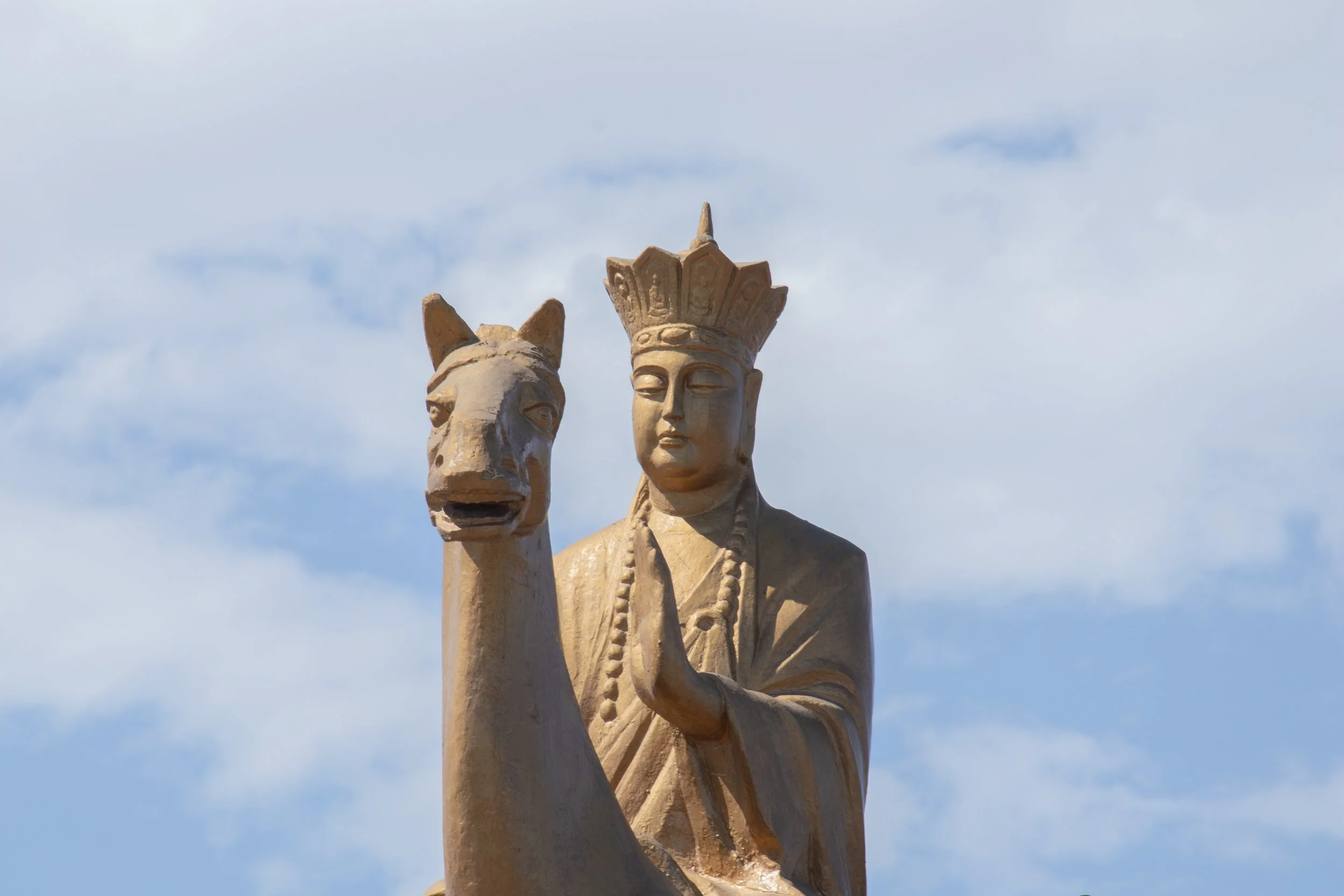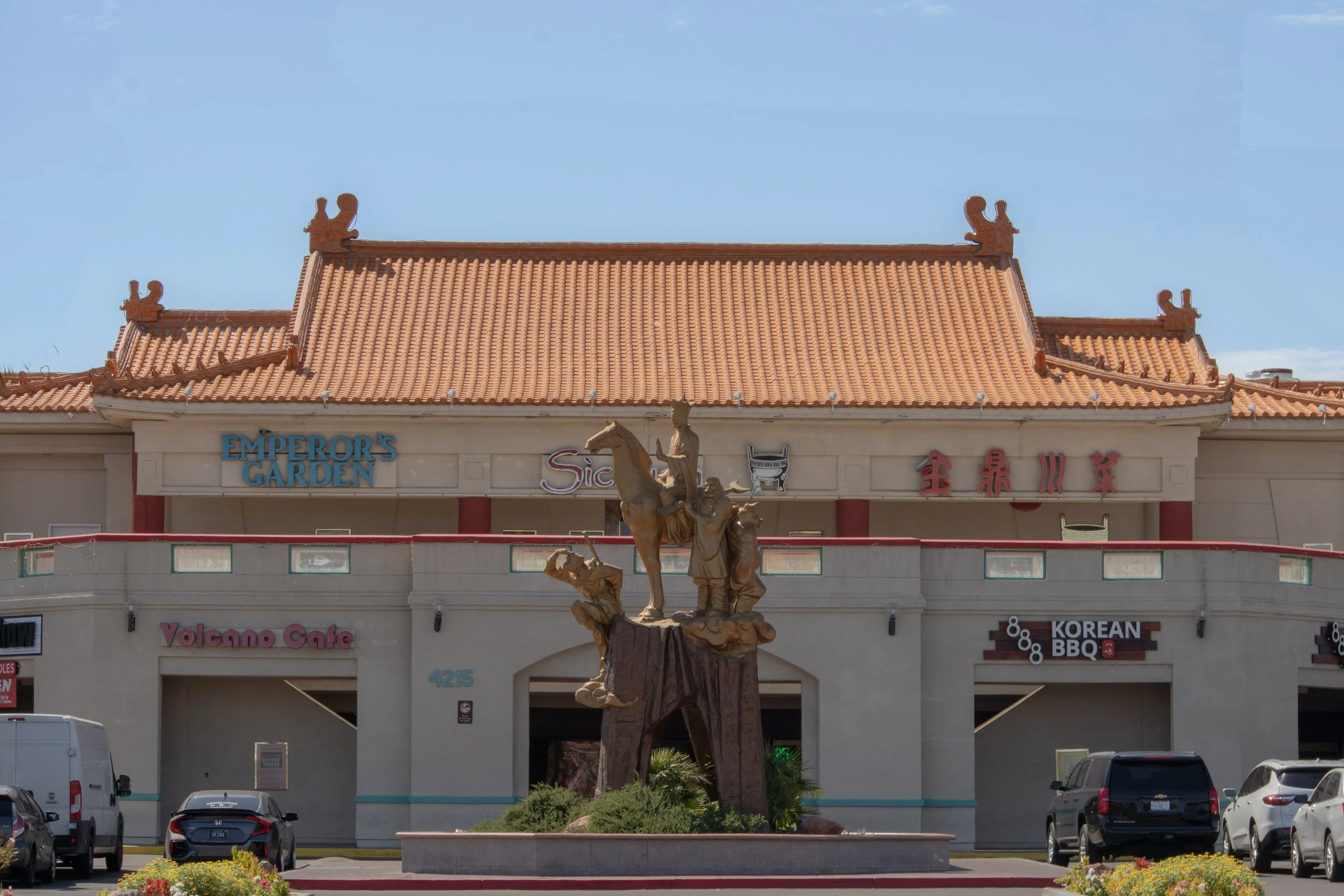The Las Vegas Issue
Making Space
Community at Vegas’ “master-planned” Chinatown
It’s impossible not to be astonished by the landmarks that distinguish this part of town: an extravagant gateway, golden statues, elaborate hip-and-gable rooftops. But perhaps I’d be less surprised by the sight of these cultural objects if it weren’t for their unexpected surroundings — a plaza structured like an outdoor megamall rather than the historic Chinatown neighborhoods it shares a name with.
Aesthetically, the Las Vegas Chinatown parallels many other designated Chinatowns in America, blending urban architecture with ethnic embellishments that visibly declare the place’s function as a hub for Chinese culture. Unlike the others, however, this Chinatown is no town at all. Upon arriving, we discover a sprawling district consisting solely of over twenty different shopping complexes. There are no homes to be found here, only boundless acres of stores and parking spaces.
What little history I know of the area explains its total commercialization. The Vegas Chinatown didn’t start out as an immigrant settlement as most Chinatowns do, and at the time of its establishment, the local Chinese population wasn’t large enough to drive such a major development. Instead, the entire district was a business endeavor conceived by Taiwanese-American entrepreneur James Chen in 1995, who called his project “America’s first master-planned Chinatown.”
Standing here, I’m unsure of what this attempt to recreate a Chinatown has meant for Chinese culture in Vegas. Artificial origins or not, the impressive scale of this operation and the grandeur of its cultural monuments cannot be denied; even in this punishing heat, we linger outside just to capture photographs of the plaza’s traditional Chinese paifang, our bodies dwarfed by the enormous gateway. Plus, there’s no shortage of wares and cuisines to pick from here. It’s almost lunchtime, and sure enough, a few families have started to arrive, presumably headed to the indoor mall for a meal. The scene makes me curious to know how the offerings inside might compare to their shiny exterior.
We then make our way to the mall. Although the building is slightly rundown, we aren’t any less entertained by what we find. Children run around playing tag in the halls, where their mothers also sell jewelry and make small talk. One elderly man near the entrance invites us to peruse his assortment of glittering Buddha statues and Asian ceramics. Nearby, a woman attends to boxes of myriad herbs and medicines, oblivious to our curious stares. And in another store, we brush shoulders with fellow customers between a narrow maze of shelves, well-stocked with trendy Asian pop culture merchandise. There’s evidently a broad mix of people who are served by this district. While it might include tourists seeking a taste of something vaguely foreign, it also includes those simply searching for a taste of their own culture.
These audiences aren’t too far off from ones you would find in Chinatowns elsewhere. After all, the distillation of culture into its most widely palatable commodities — certain foods, decorations, popular merchandise — is a practice equally embedded in the nation’s very first Chinatowns of San Francisco or New York, born out of the need to sell and survive in the face of discrimination and de facto segregation.
Yet I realize now what’s been troubling me since I arrived. The fact that this Chinatown doesn’t share quite the same history makes its deliberate adoption of the label, along with its associated aesthetics, something to be examined. Particularly in places originally devoid of geographic enclaving, who is being served by this insistence on corralling Chinese or Asian businesses into separate, exotified districts?
Perhaps part of the answer is the city itself. Vegas works hard to take you anywhere but here, to replicate something and sell you the spectacle of it; the city’s glittering Chinatown, which profits from maintaining a fantastical veneer of rich heritage, has been unable to escape this same tendency.
Even so, co-existing with this reality is the fact that I’m here, that people who look like me are here today. Despite issues surrounding the implications of its history and design, the Las Vegas Chinatown has been an integral pocket of culture and food for the Asian community of Nevada, which is now ninefold what it was when the Chinatown was first established. We have always needed spaces like this, and we have often carved them out for ourselves. Under what appearances, conditions, or labels, though — that’s something that can and should continue to be negotiated. There’s an opportunity, here, to reconcile what this place has been with what else it could someday be.
It’s time for us to leave. At the bakery near the exit, Niko buys a pineapple bun for the road. The rest of us decide to depart without sustenance; still, we take a few minutes to gush over the displays, coveting the nostalgic flavors behind the glass. It’s this moment that reminds me, vividly, of other Chinatowns that I’ve visited in the past. It’s like if I turn around now, I’ll see my father, a box of golden tarts in his arms, his head bent in conversation with a storekeeper in some city miles from where we stand now. If I turn around now, I might see myself, still searching for meaning in these spaces we inhabit.
The contradictions of this place, and this city, weigh on me. I let them. I hold them close, imagining what else they might one day become.
Words: Darice Wong
Photos: James Nguyen, Niko Frost



